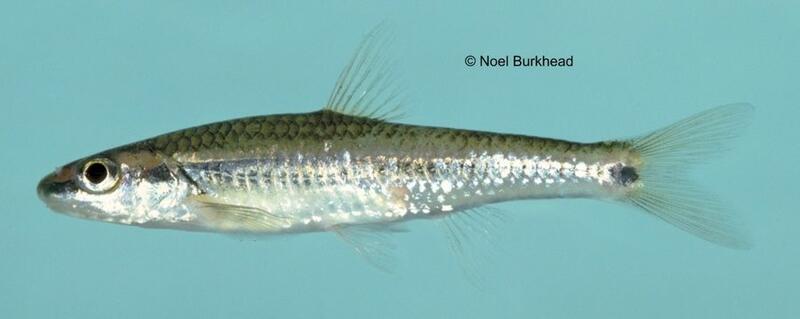







Loading profile. Please wait . . .
Hybopsis lineapunctata Clemmer and Suttkus, 1971
Lined Chub




Federal Protection: No US federal protection
State Protection: Rare
Global Rank: G3G4
State Rank: S2
Element Locations Tracked in Biotics: Yes
SWAP 2015 Species of Greatest Conservation Need (SGCN): Yes
SWAP 2025 Species of Greatest Conservation Need (SGCN): Yes
2025 SGCN Priority Tier: High Conservation Concern
Element Occurrences (EOs) in Georgia: 62
Habitat Summary for element in Georgia: Upland creeks over sandy substrate with gentle current
The lined chub has a prominent snout overhanging an inferior mouth (a mouth that opens on the underside of the head). Adults reach about 85 mm (3⅜ inch) total length. It usually has a pair of maxillary barbels in the corner of the mouth that may be difficult to see without magnification. Its dark lateral stripe ends in a distinct caudal spot and is bordered above by a pale white area that is most discernible on the rear half of the body. The upper half of the body is yellow to golden and the belly is silvery-white. There are no reported differences in coloration between females and males.
The lined chub may appear superficially similar to the burrhead shiner (Notropis asperifrons), but the latter species has a less prominent snout and never has barbels. The burrhead shiner is further differentiated by having a pharyngeal tooth count formula of 2-4-4-2 (vs. 1-4-4-1).
The lined chub is usually found in pools in small and medium-sized streams and near the shoreline in sections of rivers with moderate current. It is commonly collected over sandy substrates.
The lined chub is an opportunistic invertivore. Both terrestrial (e.g., spiders, beetles, true bugs) and aquatic (e.g., midges, mayflies, caddisflies) invertebrates have been documented in gut content studies.
Very little is known about the life history of the lined chub. Spawning occurs minimally between May and June, but examination of gonads suggests that it may start as early as March.
Minnows are very vulnerable to seining and other standard sampling techniques. This species could be easily overlooked when sorting live fishes in the field. As long as the collector has a valid scientific collecting permit, it is appropriate to keep a voucher specimen to document new stream and watershed-level occurrences of the lined chub.
The lined chub is endemic to both the Coosa and Tallapoosa river systems (Alabama River drainage) within the states of Alabama, Georgia, and Tennessee. Most of the Coosa River system records in Georgia are from the Ridge and Valley physiographic province. Check the Fishes of Georgia Webpage for a watershed-level distribution map.
This species has a wide but very spotty distribution within the upper Coosa River system. Long distances separate most populations, which makes them especially vulnerable to local extinction. This distribution pattern also exposes the lined chub to a wide array of threats, including urbanization, impoundments, and failure to follow agricultural best-management practices.
| Threat 1 | Threat 2 | Threat 3 | |
|---|---|---|---|
| General Threat | Pollution | Natural system modifications | Residential & commercial development |
| Specific Threat | Agricultural & forestry effluents | Dams & water management/use | None |
Analysis of collection records in the upper Coosa River system suggests that many populations of the lined chub have already been lost. Remaining populations are limited in number and isolated by long distances. Based upon trends in Georgia, Warren et al (2000) considered the lined chub to be vulnerable to imperilment. There are many recent records of the lined chub within the upper Tallapoosa River system, where this species is apparently stable. However, many ichthyologists have recognized differences between the populations in the Tallapoosa and Coosa Rivers, elevating the importance of protecting populations in the Coosa system.
Conserving populations of the lined chub will require general watershed-level conservation and restoration practices. Incentive programs to help farmers implement best-management practices could improve instream habitat by decreasing sediment, nutrient, and chemical runoff and increasing riparian forest cover. Conservation groups should work cooperatively with developers and local governments to minimize the impacts from new home construction and commercial development. Additional water withdrawals and impoundments should be minimized by promoting water conservation practices and augmenting existing water storage whenever possible.
Boschung, H. T. and R. L. Mayden. 2004. Fishes of Alabama. Smithsonian Books, Washington D.C. 736 pp.
Clemmer, G.H., and R.D. Suttkus. 1971. Hybopsis lineapunctata, a new cyprinid fish from the upper Alabama River system. Tulane Studies of Zoology and Botany 17(2):21-30.
Etnier, D.A. and W.C. Starnes. 1993. The fishes of Tennessee. The University of Tennessee Press, Knoxville. 689 pp.
Georgia Department of Natural Resources. 1999. Protected animals of Georgia. Wildlife Resources Division, Nongame Wildlife and Natural Heritage Section, Social Circle. 247 pp.
Mettee, M. F., P. E. O'Neil, and J. M. Pierson. 1996. Fishes of Alabama and the Mobile basin. Oxmoor House, Birmingham, Alabama. 820 pp.
Skelton, C.E. and B. Albanese. 2006. Field guide to the fishes of the Conasauga river system. U.S. Forest Service, Gainesville, Georgia. 251 pp.
Brett Albanese
Jul-08